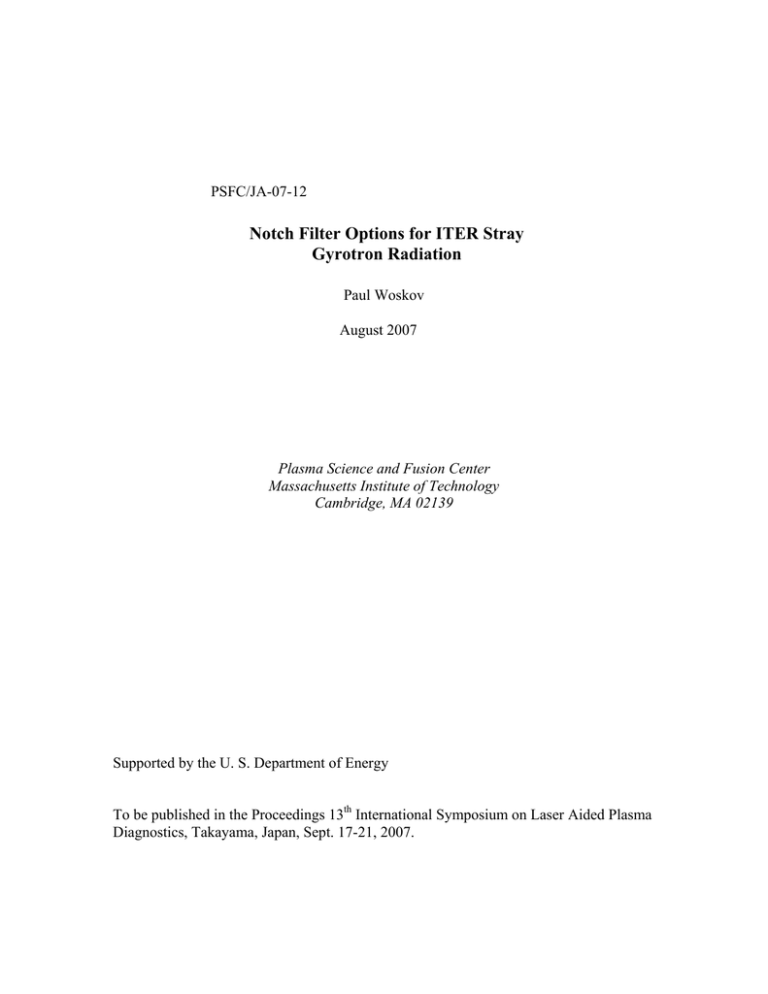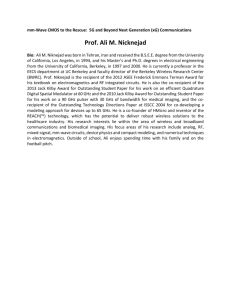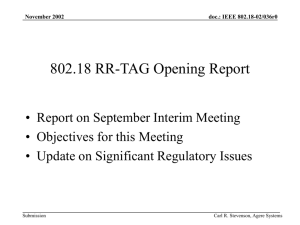Notch Filter Options for ITER Stray Gyrotron Radiation
advertisement

PSFC/JA-07-12 Notch Filter Options for ITER Stray Gyrotron Radiation Paul Woskov August 2007 Plasma Science and Fusion Center Massachusetts Institute of Technology Cambridge, MA 02139 Supported by the U. S. Department of Energy To be published in the Proceedings 13th International Symposium on Laser Aided Plasma Diagnostics, Takayama, Japan, Sept. 17-21, 2007. Notch Filter Options for ITER Stray Gyrotron Radiation Paul Woskov MIT Plasma Science & Fusion Center, Cambridge, MA 02139, U. S. A. ITER will have multi megawatt gyrotron systems at 170, 120, and potentially at 60 GHz for ECH, current drive, NTM control, start up, and CTS diagnostics. The ITER environment will therefore have significant background levels of stay radiation at these frequencies that can pose a problem to a number of diagnostic systems. Several deep, narrowband reject filter approaches have been examined. These include fundamental mode waveguide filters, quasi-optical resonance filters, and molecular absorption gases. candidate absorption gases for the ITER gyrotron frequencies. 1. Introduction The current plans for ITER include twenty-four 1 MW 170 GHz gyrotrons for electron cyclotron heating (ECH), current drive, and neoclassical tearing mode (NTM) control [1], three 1 MW 120 GHz gyrotrons for start up [1, 2], and two proposed 1 MW 60 GHz gyrotrons for fast ion collective Thomson scattering (CTS) diagnostics [3]. Consequently there will be significant stray radiation at these frequencies and ITER diagnostics [4] with detectors having sensitivities to this radiation will be adversely affected. Diagnostics that operate at higher frequencies in the infrared such as density interferometry/ polarimetry and thermal emission bolometry can be shielded by high pass meshes [5] or dichoric filters [6]. However, millimeter-wave to terahertz diagnostics such as reflectometry, refractometry, electron cyclotron emission (ECE), and collective Thomson scattering (CTS) which operate around these frequencies will require narrow band notch filters with stop bands wide enough to block multiple drifting gyrotron frequencies [7] and at the same time have wide, low loss pass bands outside the notches. Several notch filter approaches are possible. Fundamental mode rectangular waveguide filters with many side coupled resonator cavities have been successfully used up to 140 GHz with rejection depths of up to -100 dB [8, 9]. Quasi-optical resonance cavities with rejections up to -40 dB in the 100 – 140 GHz have also been reported [10, 11] and a molecular absorption gas (N2O) has been used at 778 GHz with a rejection of over -60 dB [12]. The relative merits of each of these technologies is briefly discussed here along with a new compact, rugged quasi-optical resonator notch filter design and 2. Fundamental Waveguide Filters Narrow stop band filters fabricated in standard rectangular waveguide with a dozen or more cylindrical side cavities tuned to the reject frequency are a well established technology [8, 9] and have been successfully used at many fusion plasma experiments in the 70 to 140 GHz range. Extending this technology to 170 GHz will be challenging because the dimensions for the waveguide and resonators become very small, making them difficult to fabricate and increasing ohmic losses with frequency will reduce resonator q and increase insertion losses. Another difficulty is that the pass bands on either side of the notch frequency are narrower that the waveguide band in which the filter is built. This limitation is illustrated in Figure 1 where a measured transmission spectrum for one of the 110 GHz notch filters used on the TEXOR fast ion CTS system [13] is shown. The measurement was made with a millimeter-wave extended Agilent Model E8363B Network Analyzer. The Transmission (dB) 0 -20 -40 -60 -80 100 105 110 115 120 Frequency (GHz) Fig. 1: Transmission through TEXTOR CTS Notch B WR08 waveguide filter with 16 resonators. Central notch at 109.95 GHz is 200 MHz wide below 60 dB. 1 deep notch at 110 GHz is flanked by low insertion loss (< 3 dB) pass bands that extent only about 6 GHz on the low frequency side and 3.6 GHz on the high side due to other cavity modes in the filter. Such pass band limits would be a problem for very wide band diagnostics such as ECE and reflectometry. 3. Quasi-Optical Resonance Filters Resonance filters based on optics are more easily extended to higher frequencies, but are more difficult to mechanically and thermally stabilize and to achieve high q in free space propagation. There are many possible configurations [11]. One that is easily implemented is a variation on the Fabry-Perot resonator [10] as illustrated in Fig. 2. The transmission for such a filter is given by: t (1 − l ) + 4l sin 2 δ Fig. 3: Quasi-optical notch filter range in corrugated waveguide shown with polyethylene beamsplitter. Internal dia. is 20 mm. about 26 mm corresponding to a FSR of 5.7 GHz. The repetitive notches have rejections of > -30 dB over bandwidths of 56 MHz with a peak rejection approaching -40 dB, and 3 dB pass bands of 4.4 GHz with a minimum insertion loss of -0.7 dB. A plot of Eq. (1) shown overlaid on the measurement fits the data for single pass factor of l = 0.996. Measurements with a polyethylene beamsplitter with t = 0.69 at 110 GHz resulted in l = 0.921 and peak notch depths of only -17 dB and minimum insertion losses of -0.2 dB. In another test the mirror separation was decreased closer to the diameter of the waveguide to increase the FSR to 6.7 GHz. This type filter could be used as a building block in units of two or more to tailor the stop band to the needed rejection depth and bandwidth. 2 T= 2 (1 − tl ) + 4tl sin δ 2 2 2 (1) where t is the transmission through the beamsplitter, l is the single pass transmission factor between the mirrors, and δ = 4π L λ for wavelength λ. The transmission characteristic has a series of notches separated by the free spectral range (FSR) of c/2L with the depth and spectral width depending on the beamsplitter transmission and single pass factor. Beamsplitter 0 Transmission (dB) Signal L Mirror Fig. 2: Design of quasi-optical resonance notch filter -10 -20 -30 -40 The realization of this type filter in corrugated waveguide is shown in Fig. 3. The use of HE11 corrugated waveguide makes it possible to avoid free space diffraction making it compact and mechanically rugged. This filter has an internal diameter of 20 mm with a corrugation depth and pitch for the 90 – 140 GHz range. The side mirror pugs are tuneable and both polyethylene and quartz beamsplitters have been used. Measurements with a quartz beamsplitter with a transmission t = 0.46 at 120 GHz for the E-field perpendicular to the plane of Fig. 2 are shown in Fig. 4. The mirror separation in this case was 110 115 120 125 130 Frequency (GHz) Fig. 4: Measured (solid line) and calculated for l = 0.996 (dashed line) transmission through quasi-optical interference filter with 1.5 mm thick quartz beamsplitter for E-field polarization perpendicular to the plane of Fig. 2 Care would need to be taken in the spacing between such resonators since they reject by reflection and the potential for mutual interference would need to be considered. Also novel arrangements where additional filters of 2 this type with different FSR are used as the mirrors for the main filter could be used to eliminate the repetitive pattern of notches at the expense of increasing the insertion loss to the beamsplitter transmission. a minimum rejection of -60 dB over a 500 MHz wide notch at the 170 GHz transition is illustrated in Fig. 6. A path length of about 10 m at a pressure of 70 torr would achieve this specification with an insertion loss < 1 dB in the adjacent pass band centered at 163.6 GHz. However, with these parameters the filter cell would only have a peak rejection of 4.3 dB at the 61 GHz frequency so it may be difficult to use this gas to simultaneously reject all the gyrotron frequencies. Also the many absorption peaks in this rotational band that come to a peak at 474 GHz and extend well into the THz frequency range may not be a desirable feature for some diagnostics. 4. Molecular Absorption Gases The rotational energy levels of many molecules occur in the millimeter-wave wavelength range. A successful notch filter molecule should be small (diatomic or triatomic) to minimize additional absorptions outside the notch frequency. A survey of the JPL NASA molecular absorption data base [14] revealed two common molecules with relatively strong transitions and simple spectra near the ITER gyrotron frequencies. 4.2. H2S Molecule Length (m) The millimeter-wave absorption spectrum in the 40 – 250 GHz range for the carbon sulphide (OCS) molecule is shown in Figure 5 for three different pressures assuming Lorentzian line broadening with a half width of 6.22 MHz/torr [15] and summing over all transitions between 24 and 280 GHz. It has a series of rotational absorptions separated by 12.16 GHz with peaks at 60.8, 121.6, and 170.3 GHz having peak absorptions of 0.4, 3.2, and 8.0 dB/m, respectively, occurring close to the ITER gyrotron frequencies. Thus in principle this one gas could be used as a notch filter for all the ITER gyrotrons. 10 40 8 30 6 loss 20 4 lenght 10 0 2 0 100 200 0 300 Pressure (torr) Fig. 6: OCS pressure - path length dependence for -60 dB minimum rejection over 500 MHz bandwidth at 170.3 GHz and insertion loss at 163.6 GHz (dashed line). 0 Transmission (dB/m) 50 Insertion Loss (dB) The hydrogen sulfide (H2S) molecule has only two prominent features in the 40 – 250 GHz range with one at 168.8 GHz near the 170 GHz 4.1. OCS Molecule -5 gyrotron frequency. The H2S absorption spectrum is shown in Fig. 7 for three pressures assuming Lorentzian broadening with 7.18 MHz/torr half width [16] and summing over all transitions up to 370 GHz. At atmospheric pressure the 168.8 GHz transition is sufficiently broadened to have an absorption strength of 8.6 dB/m at 170 GHz. A 7 m long path length would achieve 60 dB attenuation at 170 GHz with an insertion loss of < 3 dB below 144 GHz. The required pressure for a given attenuation could be lowered with longer path lengths or with a gyrotron frequency closer to 168.8 GHz. Lowering the pressure would increase the pass bandwidth closer to the 168 GHz frequency and reduce insertion losses. -10 10 Torr 100 Torr 760 torr -15 -20 50 60 100 120 150 170 200 250 Frequency (GHz) Fig. 5: Absorption spectrum of the OCS molecule at various pressures. In practice this gas filter would need to be used at low pressure (< 100 torr) to minimize the insertion loss between the absorbing lines. The trade off between gas pressure and path length for 3 Like OCS there are many stronger absorption lines in H2S above 250 GHz so this molecule would not be useful for diagnostics such as ECE requiring a broad pass band to over one THz. In addition, the infrared absorption bands of these molecules would need to be carefully examined to determine if they could be used as gyrotron blocking filters for infrared interferometry/ polarimetry or bolometer diagnostics. of the notch filter approaches described here have efficient transmission at 1000 GHz. Acknowledgments The author thanks R. J. Temkin and J. R. Sirigiri at MIT PSFC for access to the Agilent network analyzer and F. Meo and J. Holm of Risø National Lab., Denmark for providing and assisting with the TEXTOR filter measurements. Transmission (dB/m) 0 References [1] G. Bosia, Proceedings of the 12th Joint Workshop on Electron Cyclotron Emission and Electron Cyclotron Heating, World Scientific, Singapore (2003) 571. [2] K. Takahashi, N. Kobayashi, A. Kasugai and K. Sakamoto, J. Phys. Conf. Series 25 (2005) 75-83, www.iop.org/EJ. [3] H. Bindslev, F. Meo, E. L. Tsakadze, S. B. Korshlom, P. Woskov, Rev. Sci. Instrum. 75, part II, (2004) 3598-3600. [4]A. J. H. Donné et al, Nucl. Fusion 47, (2007) S337-S384. [5] R. Ulrich, Appl. Optics 9, (1977) 2511. [6] C. Winnewisser, IEEE Trans. Microwave Theory and Tech. 48, (2000) 744. [7] P.Woskov et al, Rev. Sci. Instrum.77,(2006) 10E524. [8] T. Geist and M. Bergbauer, Int. J. Infrared and Millimeter Waves 15, (1994) 2043. [9] Yu. Dryagin, N. Scalyga, and T. Geist, Int. J. Infrared and Millimeter Waves, 17, (1996) 1199. [10]P.F.Goldsmith & H.Schlossberg, IEEE Trans. Microwave Theory and Tech. 28, (1980) 1136. [11] G. G. Denisov, S.V. Kuzikov, M. Yu. Shmelov, Proc. 18th Int. Conf. Infrared and Millimeter Waves, (1993) 353. [12] P. Woskoboinikow, W J. Mulligan, and R. Erickson, IEEE J. Quantum Electronics, 19, (1983) 4. [13] H. Bindslev et al, Phys. Rev. Lett., 97, (2006) 205005. [14] http://spec.jpl.nasa.gov/ [15]J.Doose et al, Molecular Phys. 81, (1994) 20. [16]P. Helminger and F.DeLucia, J. Quant. Spect. and Radiative Transfer 17, (1977) 751. -2 -4 -6 10 Torr 100 Torr 760 Torr -8 -10 5060 100 120 150 170 200 250 Frequency (GHz) Fig. 7: Absorption spectrum of the H2S molecule at various pressures. 5. Conclusions Filtering stray gyrotron radiation in ITER will be a challenging problem for ITER diagnostics. The need to filter up to three gyrotron bands with deep rejection in narrow bands, but not too narrow to accommodate multiple drifting gyrotron frequencies in each band, while at the same time having broad low insertion loss pass bands will be a difficult requirement to meet in many cases. The fundamental mode waveguide filters, quasi-optical resonance filters, and molecular absorption gases described here all have limits in terms of their rejection and pass band capability. Each diagnostic will need to customize its stray gyrotron radiation rejection approach. For example, the fast ion CTS diagnostic could use a combination of a fundamental waveguide notch filter at 60 GHz, H2S fill in the receiver waveguide for 170 GHz rejection and a blocking switch during start up for 120 GHz. Refectrometry diagnostics which will operate below 160 GHz could also use a combination of rejection filter technologies described here. On the other hand ECE diagnostics that need to cover a broad range of spectrum from 100 to over 1000 GHz will likely need to operate in low and high bands since none 4





